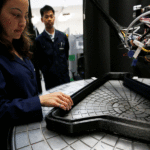Focus on ASEAN – Thailand and Vietnam

Concluding our series on trading prospects with ASEAN nations in the run up to the Sydney summit, we look at Thailand and Vietnam.
Thailand
Thailand is ASEAN’s second largest economy, after Indonesia. It is an upper middle-income country with robust export-oriented industries and strengths in agribusiness, tourism, automotive and electronics manufacturing.
Around 60 per cent of Thailand’s GDP comes from services, including tourism, 27 per cent from a diverse industrial and manufacturing base and eight per cent from the agriculture sector. Thailand is a regional and global manufacturing hub for vehicles, automotive components, consumer electronics, and processed food and beverages.
The diversity of Thailand’s industrial sector is a key driver of growth. Thailand also provides access to the Greater Mekong sub-region, where the emerging markets of Myanmar, Vietnam, Cambodia and Laos offer additional business opportunities.
‘Thailand 4.0’ is the country’s ambitious, 20-year plan to create a value-added, innovative and knowledge -based economy, with an increased focus on services. The Government is looking to boost Thailand’s international competitiveness in high-potential industries as part of this plan.
Opportunities for Australian companies can be found where Thai companies are looking for solutions and partnerships to enhance their market position, technical capabilities and operational effectiveness. Australian companies are already well-represented in Thailand, particularly in advanced manufacturing, logistics, and professional and financial services.
Australian companies have further prospects in areas such as digital transformation, as Thailand’s digital economy is expanding at a rapid rate, following major investments in ICT infrastructure. Thais are some of the most active users of smartphones in the region, and the e-commerce market, currently valued at more than US$3 billion, is forecast to grow by 15 per cent over the next five years. Banks and businesses are also looking for innovative solutions to operate more efficiently and take advantage of new online business models.
Smart cities play an important role in this scheme and Thailand has embarked on an ambitious infrastructure development program to upgrade its connectivity, logistics capacity and competitiveness. Rail, road, airports and sea ports projects worth over US$25 billion are expected to be delivered with funding coming from a mix of state financing, public-private partnerships, and foreign direct investment.
The Thai Government is accelerating the development of smart cities programs in key regional areas to further improve transport, education, healthcare and tourism services across the country.
There are also opportunities for Australian technology, services and know-how to enhance industry capabilities and competitiveness, particularly in agriculture, healthcare, communications, cybersecurity, aviation, e-government and financial service technologies.
Thailand is the manufacturing, processing and distribution centre of Southeast Asia. With over 10,000 food manufacturers in the country alone, there’s demand for modern packaging and processing equipment which can improve operational efficiency and meet the needs of more discerning consumers in Thailand’s key export markets.
Thailand has ambitions to become an aviation hub and is preparing itself for the expected tripling of the regional airline fleet over the next 20 years. To succeed, the industry will require the latest technologies, maintenance capabilities and skilled personnel. and Australian exporters with relevant capabilities, such as maintenance, overhaul and vocational training, are well-positioned to support this growth.
Bangkok is the most visited city in the world, attracting more than 21 million visitors in 2016 – more than Paris, New York or London. Over 800,000 Australians travel to Thailand every year and the Government is investing heavily in Thailand’s six major international airports to service an anticipated increase in tourist arrivals to 47 million by 2020. The tourism sector is therefore looking for better ways to provide unique experiences and operate sustainably.
The rising middle class continues to drive demand for quality school, university and vocational training to support Thailand 4.0 priorities and to build a globally competitive workforce. Thailand is also a healthcare leader in the region and the Government is encouraging more investments to position the country as the medical and wellness centre of ASEAN.
Vietnam
Vietnam is likely to remain a standout growth market in ASEAN in coming years with favourable demographics, strong international export orientation and robust domestic economic activity. Accelerating urbanisation, a young median age of 30 years, and a middle class tracking to reach 33 million by 2020 – the fastest rate of growth in ASEAN – is also helping to expand Vietnam’s economy.
The Vietnamese Government has put international economic integration at the centre of its plans. Vietnam is a significant export manufacturer and its export-oriented economic model has remained resilient in the face of weak global trade. The country has also emerged as a manufacturing hub for electronics, garments and footwear.
Goods and services exports now comprise over 90 per cent of Vietnam’s GDP, up from 30 per cent in the mid-1990s. Vietnam is a significant trade partner for Australia, underpinned by strong people-to-people links. Vietnam is Australia’s fastest-growing export market in ASEAN, growing 11.3 per cent annually on average over the past decade. Trade in services, particularly professional services and education, are emerging areas of growth
Opportunities for Australian companies include education, as with other countries in the region. Vietnam is encouraging internationalisation of education as part of its ‘Industry 4.0’ agenda, including vocational education and partnerships, and Australian business is playing a leading role in this sector, with a focus on education and skills development. RMIT was the first foreign university to establish a campus in Vietnam in 2000.
Vietnam’s construction and infrastructure sector is expected to grow steadily to 2025, supported by targeted government reforms. Vietnam wants to establish public-private-partnership projects, creating opportunities for private companies to enter the infrastructure market.
Australian companies can support Vietnam’s infrastructure priorities and smart cities initiatives across services such as e-government, traffic management, education and healthcare. Aviation is a another priority development sector, supported by strong growth in passenger numbers and freight. Vietnam is seeking foreign investment and expertise to lift the skills of its labour force and improve aviation infrastructure capacity and aerospace manufacturing capability.
Healthcare services: Public and private sector healthcare expenditure is growing in excess of 10 per cent per annum. Investments in the sector are focused on upgrading technology to meet international standards, expanding the pharmaceutical supply chain, and establishing international partnerships, including with Australia, to support the improvement of healthcare capabilities.
Vietnamese consumers are increasingly concerned about food safety and are demanding higher-quality food and beverage products. Supermarkets are starting to overtake traditional wet markets and Japanese, South Korean and Thai retailers are already operating in Vietnam.
It’s estimated that by 2020, Vietnam will have over 1,200 large supermarkets and hypermarkets, in addition to thousands of convenience stores. An increasing preference for dining out, the expanding tourism sector and AANZFTA-driven tariff cuts continue to drive strong growth, particularly for premium quality products.
The agribusiness sector generates 16 per cent of Vietnam’s GDP and comprises nearly one-sixth of exports. Vietnam has set policies to prioritise high-tech agribusiness development, increase productivity and protect the environment. These policies incentivise R&D, worker training and development of hi-tech agribusiness – all areas offering scope for Australian business to pursue collaborative partnerships.
Hydropower, gas and coal are Vietnam’s three main energy sources. Vietnam became a net coal importer in 2016, and gas production is forecast to decline from 2020, fuelling the need for infrastructure such as deep -water ports, LNG terminals and distribution networks to end users.
Vietnam’s Industry 4.0 agenda and National Energy Development Plan emphasise the importance of improved energy performance and efficiency and Australian firms with expertise in solutions that combine technology, equipment and services to drive increases in productivity and efficiency would be highly competitive.
For more information, see the ASEAN Now report from Australia Unlimited from which this data was derived.








